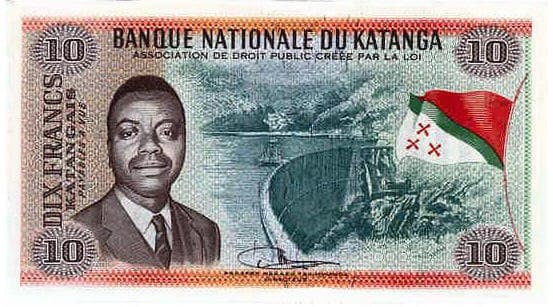This second article in a series of deep dives into alternative historical depictions of Africa and Colonialism in video games focuses on Congo. Following the independence of Congo in 1960 its southernmost province of Katanga broke away as its own republic, receiving heavy Belgian and mercenary support. A popular Hearts of Iron IV mod set in the 1960s depicts an alternative Katanga. How does it fare?
Introduction
Hearts of Iron IV is again the game of today’s topic but this time the focus is on The New Order: Last Days of Europe. The New Order (or TNO for short) takes place in an alternative 1960s based on the war aims of Germany in World War 2, which has managed to achieve victory over the Allies alongside its Axis partners. The United States and the remnants of the British Commonwealth stand alone against the powers of fascism and national socialism, which have begun a slow decline comparable to the USSR in our time as an alternate Cold War sets in. A similar entity to Mittelafrika as discussed in the previous article exists in Africa, but it is not quite the same for reasons explored in this article. Over the course of the mod’s narrative a series of events similar to the Congo Crisis of 1960 to 1965 which began with Katanga’s secession occur. The divergent world powers and dominant ideologies lead to different power dynamics in the conflict as it unfolds.
Brief History of the Republic of Katanga
33.7% of the revenue of the Belgian Congo came from the sale of the copper mined in the Katanga province. A Belgian state mining company, Union Minière du Haut Katanga (UMHK) was responsible for handling mining operations in the region. It became one of the most important assets in the debate regarding Congolese independence as indigenous leaders wanted to nationalise the company to secure its profits for the people, while Belgian interests were intent on keeping at least a majority stake in its shares. In January 1959, it was announced that Belgium would cease its colonial project in Congo in June 1960. When the time finally came, Congo was rife with political factionalism and ethnic conflict. Moïse Tshombe, a politician for Confédération des associations tribales du Katanga (CONAKAT) belonging to the Lunda ethnic group, accused the leading figure in the Congolese independence movement Patrice Lumumba of communist sympathies and dictatorial rule. Tshombe then declared Katanga’s secession from Congo and petitioned for Belgian recognition and support. UMHK, interested in staying in Tshombe’s good graces, gave the new state 1250 million Belgian Francs (around 3.1 billion euros). This money was invested in an army, the Katangese Gendarmerie, which was primarily staffed by white Belgian officers who commanded the local troops on behalf of Norbert Muke, a former Force Publique colonel. On the 16th of July the Belgian prime minister Gaston Eyskens officially recognised Katanga and created the Mission Technique Belge (Mistebel) to provide Tshombe with material and technical support.
Katangese independence proved to be particularly favourable to the white Belgian community in Elisabethville, who had plantations and other investments throughout the province. Tshombe had been working with the white community due to his belief that their expertise was essential to the long-term prosperity of Katanga, whereas Lumumba had been known for his fiery rhetoric about expelling whites from Congo. Lumumba notified the United Nations about Katanga’s secession and claimed it was an act of Belgian aggression against his independent nation. Opinions in the UN council were divided, as most nations remained neutral on the notion of peacekeeping efforts in the Congo or quietly disapproved of dragging troops into what was to them merely a regional dispute. International opinion did not fare much better; particularly in the United States, the matter of Katanga proved itself a focal point of politicians’ stances on African nationalism and decolonisation. Conservatives saw Lumumba’s constant attempts to petition for Soviet aid whenever the UN would not give him what he wanted as an indication of his communist sympathies while liberals likened Katanga to Manchukuo, a Japanese colony pretending to be a new Chinese empire in Manchuria during World War 2.
A gradual increase in UN troop presence and joint incursions into Katangese territory would slowly but surely lead to Tshombe’s capitulation on the 15th of January 1963. He would leave Congo to live in exile in Zambia and later in Spain until, through the combined backing of provincial political bosses, customary chiefs and foreign financial interests, he managed to maneuver himself to become prime minister of all of Congo in 1964. During his tenure in office he released 600 political prisoners and pardoned many Katangese gendarmes who were living in exile in Angola.
Katanga in The New Order
The New Order starts off on January 1st 1962. Instead of finding Katanga as its own nation in conflict with Congo it is subsumed into the greater region of “Reichskommissariat Zentralafrika”, an entity created by the collaborator Belgian colonial administration under German overlordship. With Germany’s victory in World War 2 and the dissolution of the Allies, global projects for peace such as the United Nations have not materialised in this world. What this means for Africa is that the kommissariats in The New Order have a similar bureaucracy as Mittelafrika in Kaiserreich. They are in fact a byzantine system of Germans ruling over European colonists who in turn broker for power with local chiefs.
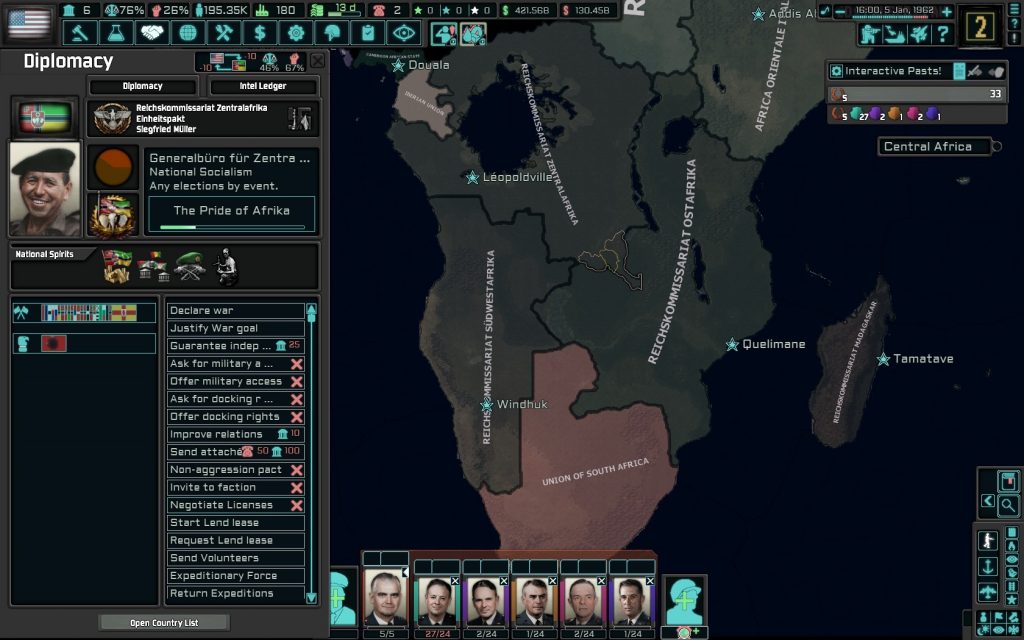
The Congolese and Central African colonial administration is led by Siegfried Müller, who in real life was in the Wehrmacht and later became a mercenary for Tshombe’s government in 1964. Müller’s kommissariat is described in-game as chiefly concerned with the profitability of the colonial industry and he has empowered sympathetic local rulers, African and European alike, to maintain order in the colony. Central Congo has also been filled with water from the Mediterranian, a leftover from Germany’s Atlantropa project. The German engineer Herman Sörgel proposed in the 1920s that the new lands generated by draining the ocean could serve as a peaceful alternative to German expansionism and that the water could be used to irrigate the Sahara desert. As The New Order is an alternative history scenario where Germany won the Second World War, the developers assumed this plan, which was stated by Sörgel as compatible with Nazi ideology, came to fruition.
Müller’s Congo in The New Order functions a lot like Tshombe’s Katanga in our world, undoubtedly because of the developers taking inspiration from the events of the Congo Crisis. A lot of the finer details regarding just how Müller’s Congo operates are left to the observer’s speculation and a recurring theme in The New Order’s African content is that it explores ideas on a rather superficial level, which is something that will become clearer as the mod’s story moves to its conclusion.
A few years into the game, Germany’s Führer Adolf Hitler passes away. His successors, the big four in the NSDAP, then plunge the nation into a brutal civil war. This effectively ends German dominance on the world stage and instability wracks its sphere of influence, not least of which Africa where the German colonies were wholly reliant on aid from Europe. To prevent their own collapse the German kommissars form a defensive alliance “The Afrika-Schild”.

Eventually this alliance is dragged into a war with South Africa and so a conflict known as the South African War. This is The New Order’s analogue to Vietnam as the United States joins South on the battlefield Africa to contain nazism, with many of the social developments in America such as Hippies the anti-war movement originating from the resistance to this conflict.
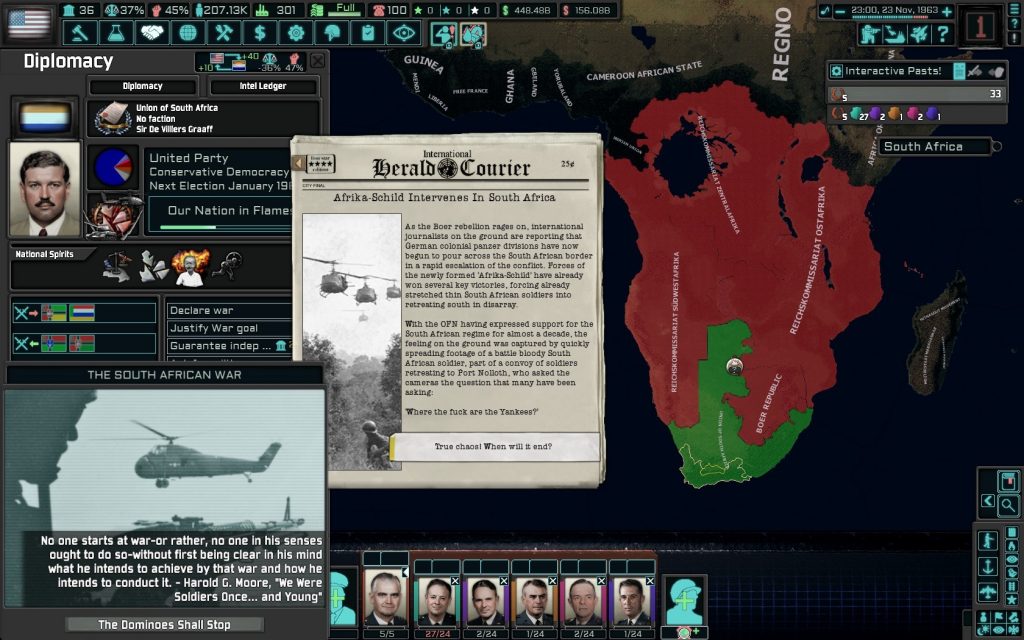
The outcome of this war will determine the future of Africa as a whole in The New Order. The grand mobilisation of native collaborators from the kommisariats against South Africa leads to critical instability across the German-African sphere and anti-colonial independence movements will lead to the downfall of the “Afrika-Schild” no matter the outcome. There are three of those outcomes; a stalemate with some gains or losses on either side, a total victory for the German colonies over South Africa wherein they overextend themselves and collapse violently and a total defeat of German colonialism through the combined force of the South African Defense Force and its American backers. For the purposes of this article, we will look at the last scenario. The United States’ alliance with the few remaining liberal democratic nations in The New Order, the Organisation of Free Nations (OFN, this world’s NATO) will enter a total occupation of the German colonies with the aim to grant them independence and entry into the American bloc at a later date.
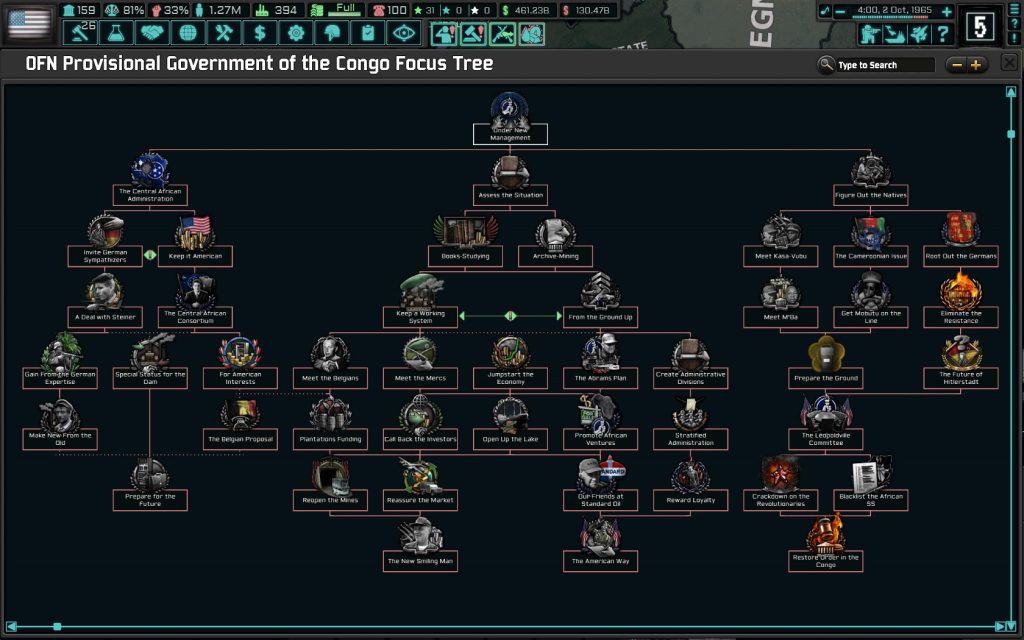
The new American administration in the Congo has to figure out which independence groups to support, which local rulers to empower and what resources to exploit to keep an independent Congo financially stable. As the focus tree of the provisional government of the Congo demonstrates, The New Order uses these American mandates in Africa as analogues for neocolonialism. The player or the AI playing Congo can choose to retain the German state apparatus and the mercenary system of Siegfried Müller with the intent to maintain stability through conservative rulership, but this means the native peoples of Congo remain disempowered and start opposing your government. The opposite is also true, as booting the Germans out of their positions of power will cause them to engage in low intensity guerrilla warfare against the American occupation force which harms your national stability.
The main power players among the natives in Congo are also by no means united, with different factions wanting a different style of government post-independence. Historic figure and independence activist Patrice Lumumba leads a liberal faction interested in establishing a federative republic similar to the United States. Christophe Gbenye, the leader of the Simba rebellion composed of radicalised socialist followers of Lumumba after his assasination in 1961 in real life also aims to create a “People’s Republic” of Congo in The New Order. The notorious dictator of Congo Joseph-Désiré Mobutu has a stronghold of power in the north and is the lynchpin to this world’s Congo Crisis, should the American administration mishandle things enough.
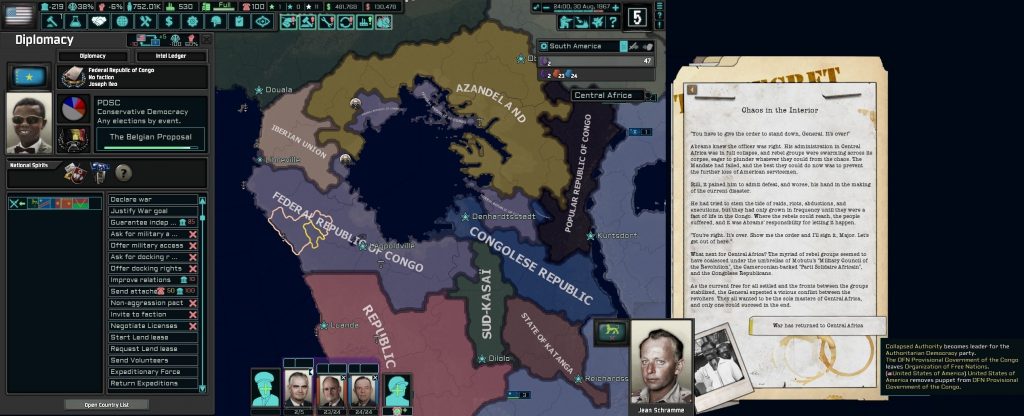
The remnants of the American mandate will side with Joseph Iléo, one of the founders of the Congolese National Movement, but will for the most part flee back to the United States as order collapses. Here we also finally see The New Order’s Katanga, a military dictatorship led by Jean Schramme. The man responsible for restarting the Katangese secession movement in 1967 by staging a coup against the Mobutu government and attempting to bring Moïse Tshombe back to Congo, Schramme led a vicious surprise attack against the Congolese National Army alongside roughly 100 white mercenaries and 600 former Katangese gendarmes. After some back and forth between Schramme’s band of hired guns and Mobutu’s troops the Belgian government repatriated him back to Europe on the 24th april 1968. Schramme brought three Congolese orphans with him who he intended to give a European education. The Katangese gendarmes who fought for him were less fortunate; Mobutu tricked them into surrendering by promising them amnesty only to promptly execute them all.
Ujuba na Takaburi
There is sadly little to no “canon” documentation on Schramme’s role in The New Order. The reason for this is that although there is still a lot to be said about the African nations in this world, almost all of them only have playable content leading up to the point of either civil war or independence. This makes them functional enough as background elements to observe while the player is doing something else like a campaign as America, but leaves a lot of room for expansion to make these states playable in their own right. In other words, as soon as the Congo Crisis is over (or Africa otherwise achieves proper independence), history for Africa in The New Order stops. A submod or expansion pack that builds on these existing stories which takes into account the various ideologies and leaders with their own vision for their countries and fleshes them out to full gameplay experiences would not only be an excellent addition to The New Order but would fill one of their biggest content gaps to date. Others within the modding community have already done great work expanding the content of the world powers of this universe, such as the Torch of Liberty team for the United States and the Yomo no Umi team for Japan. Why not Africa? The possibilities for storytelling and creativity are close to endless. Africa was greatly impacted by the ideological developments that occurred in the great powers’ blocs during our real-world Cold War and the alternative historical influences in The New Order present the opportunity to forge a completely different decolonisation and post-colonialism wherein subaltern voices that were silenced in our time have a chance to come to the forefront.
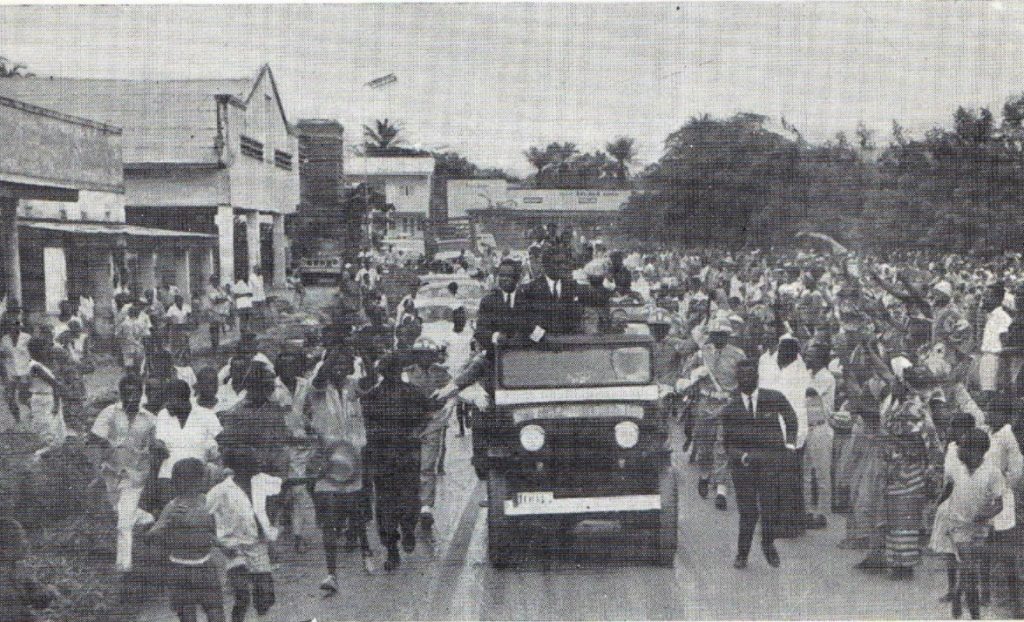
This is why I want to conclude this article with the announcement that I am working on an African content expansion pack for The New Order on behalf of VALUE and Interactive Pasts. Expect to see updates on The New Order: Ujuba na Takaburi on a semi-regular basis on TNO related social media. It is my hope to eventually include content for West and North Africa as well as Ethiopia to truly complete the playable experience in the region, but for the first release candidate the planned content is mostly going to be what you have read in this article.
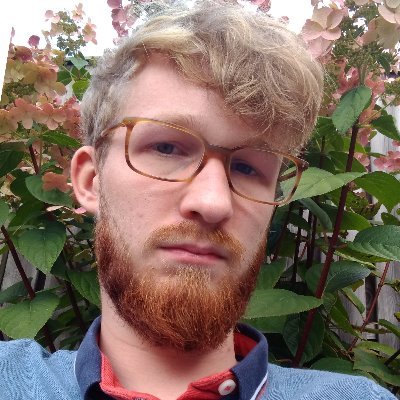
Jochem ‘Guthixian’ Scheelings is an MA student in African Studies at the University of Leiden and Intern at VALUE. He is aiming to specialise on crossing the boundaries between gaming and academia in his own field of expertise and maintains a broad interest in all depictions of Africa in video games. His speciality is immersive historical simulators by Paradox Interactive. Tweet him at @Guthixian_VALUE

